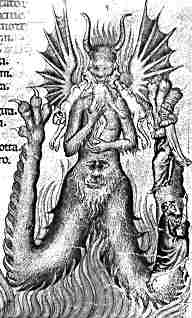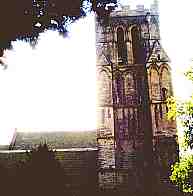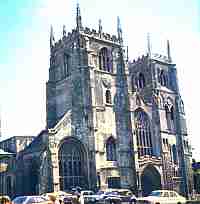

The
formerly Augustinian church at Thurgarton.

If you are looking at this page without frames, there is more information about medieval writing to be found by going to the home page (framed) or the site map (no frames).
| Religious Experience (2) | |||
| The 14th century seems to have been a time when people's minds turned to mystical things. One of the most popular and significant authors of the era, Dante, wrote a work which included an intense personal experience of greater things. The Divine Comedy is a multilayered work which includes elements of narrative, of social satire, of moral counselling and of Classical allusion, not to mention some very elegant poetry. It also gets inside the head of a man who has lost his way in what reads like a serious bout of depression. He describes his journey to the depths of hell, up the slopes of purgatory and to paradise not as a mental or imaginative exercise, but as a real physical activity, weird and strange as it is. He ends up in the presence of God. Yet somehow Dante is so often described, not as a person who has undergone and shared a mystical experience, but as an embittered political animal apportioning to his wordly enemies their own little corner of hell. Dante was a layman and wrote in his own vernacular, Italian. |
 |
||
| An illustration of Lucifer from a 14th century manuscript of the Divine Comedy (British Library, add. ms 19587), by permission of the British Library. | |||
| In the above illustration Dante and Virgil escape from hell by climbing up the furry leg of Lucifer who sits calmly munching on the bodies of the three great traitors with his three faces. You couldn't make up that sort of thing. You would have to have experienced it in some part of your head. | |||
| The life, works and social background of Dante can be explored through the Digital Dante website. | |||
| Mystical writers seem to have often come from some of the lesser travelled byways of the medieval church. Richard Rolle, whose work Incendium Amoris or The Fire of Love survives in over 40 medieval manuscript copies, was a hermit in early 14th century Yorkshire. He seems to have been an eccentric and impassioned individual. Julian of Norwich, of the later 14th century, was an anchoress attached to the church of St Julian in Norwich. Her Revelations of Divine Love was based on a series of visions she had when she was sick unto death at about the age of 30. It is not known whether she was already a recluse at this time, or whether she became one to live in a state of higher perfection after her revelations. | |||
| You can read these works in Wolters, C. 1972 Richard Rolle: The Fire of Love Harmondsworth: Penguin and Wolters, C 1966 Julian of Norwich: Revelations of Divine Love Harmondsworth: Penguin | |||
| The Julian of Norwich website provides information on the lady and on manuscripts of her work. | |||
| Another 14th century English mystic, Walter Hilton, was the head of a house of Augustinian canons at Thurgarton in Nottinghamshire. However his Ladder of Perfection was written for anchoresses. Apparently he is also thought to have been a recluse, but how he combined that with his other job is a little unclear. An anonymous work, The Cloud of Unknowing, was written by one anchorite for another intending recluse. All these authors wrote at least part of the time in English, not confining themselves to the exclusive Latin of the church establishment. |  |
||
|
The
formerly Augustinian church at Thurgarton. |
|||
| As some of the preceding examples show, mystic revelation was an area where women contributed to the literature of the church. In the 14th century this included women who had not spent their lives in enclosed orders. St Bridget of Sweden retired to a Cistercian monastery as a widow, having produced eight children. St Catherine of Siena was a Dominican tertiary, a later develoment of the order for people living virtuous lives in the normal community. Both produced visionary literature and, perhaps more extraordinarily, were activists in church politics. | |||
 |
The spiritually driven married woman trying to establish her place in the system emerges in dramatic form in the 15th century in the person of Margery Kempe. An illiterate housewife of King's Lynn in Norfolk, she dictated her visions and the accounts of her pilgrimages to a scribe. It is not politically correct to say she was crazy or the most annoying woman spawned by the middle ages, but I note that the scholar Clifton Wolters calls her "that queer, unbalanced creature". (Wolters 1966) She was no fun to go on a pilgrimage with, regularly having the vapours or ticking off her fellow travellers for not being holy enough at dinner time. She would certainly have been a surprise to the serious churchmen of earlier centuries, with their earnest debates on neo-Platonic philosophy and its place in the theory of divine revelation. | ||
| St Margaret's, the parish church of King's Lynn. | |||
| The life, works and religious environment of Margery Kempe are explored in some detail in the website Mapping Margery Kempe. | |||
| From the examples given here it might seem that all medieval mystical writers were slightly peculiar, both in terms of their personalities and their relationships to the church hierarchy. There were writers on mysticism within the ranks of mainstream church thinkers, literate clergymen with much to ponder and plenty of time to do it in. However, this is probably the most likely area of medieval religious writing to walk what was clearly seen to be a dangerous line. The possibility of personal divine revelation could not be disallowed, but it had to be separated from fraud or mental derangement. Modern doctors and psychologists come up with all sorts of explanations for the altered states of mind of those who claim true personal revelation, but those providing spiritual guidance within the church system had to separate genuine spiritual fulfilment from risky populist fantasy. Let's face it, which would you rather read, The Homilies of the Desert Fathers or The Book of Margery Kempe? | |||
|
|
|||
|
|
|||
|
If you are looking at this page without frames, there is more information about medieval writing to be found by going to the home page (framed) or the site map (no frames). |
|||